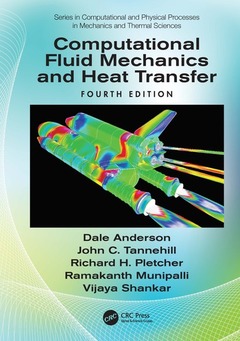Computational Fluid Mechanics and Heat Transfer (4th Ed.) Computational and Physical Processes in Mechanics and Thermal Sciences Series
Auteurs : Anderson Dale, Tannehill John C., Pletcher Richard H., Munipalli Ramakanth, Shankar Vijaya

Computational Fluid Mechanics and Heat Transfer, Fourth Edition is a fully updated version of the classic text on finite-difference and finite-volume computational methods. Divided into two parts, the text covers essential concepts in the first part, and then moves on to fluids equations in the second. Designed as a valuable resource for practitioners and students, new examples and homework problems have been added to further enhance the student?s understanding of the fundamentals and applications.
- Provides a thoroughly updated presentation of CFD and computational heat transfer
- Covers more material than other texts, organized for classroom instruction and self-study
- Presents a wide range of computation strategies for fluid flow and heat transfer
- Includes new sections on finite element methods, computational heat transfer, and multiphase flows
- Features a full Solutions Manual and Figure Slides for classroom projection
Written as an introductory text for advanced undergraduates and first-year graduate students, the new edition provides the background necessary for solving complex problems in fluid mechanics and heat transfer.
Part I: Fundamentals. 1. Introduction. 2. Partial Differential Equations. 3. Basics of Discretization Methods. 4. Application of Numerical Methods to Selected Model Equations. Part II: Application of Numerical Methods to the Equations of Fluid Mechanics and Heat Transfer. 5. Governing Equations of Fluid Mechanics and Heat Transfer. 6. Numerical Methods for Inviscid Flow Equations. 7. Numerical Methods for Boundary-Layer-Type Equations. 8. Numerical Methods for the "Parabolized" Navier–Stokes Equations. 9. Numerical Methods for the Navier–Stokes Equations. 10. Grid Generation.
Dale A. Anderson received his M.S. and Ph.D. in Aerospace and Electrical Engineering from Iowa State University; he has served as the Associate Dean in the College of Engineering at the University of Texas at Arlington, and as Director of the Computational Fluid Dynamics Center at Iowa State University. Dr. Anderson has served as a consulltant, and also in full-time positions with McDonnell-Douglas, the Boeing Company, Aerospace Corporation, the U.S. Air Force, Union Carbide, Viskase Corporation, and Lockheed-Martin.
John C. Tannehill received his Ph.D. degrees in Aerospace Engineering and Mechanical Engineering from Iowa State University, where he also served as a professor of Aerospace Engineering and Engineering Mechanics, and as Manager of the Computational Fluid Dynamics Center. Dr. Tannehill has held positions at the NASA Dyden Research Center, Aerospace Corporation, and NASA Ames Research Center, and has served as a technical consultant for several industrial firms. He is the author of numerous technical papers in the area of computational fluid dynamics, and is a Fellow of the American Institute of Aeronautics and Astronautics.
Richard H. Pletcher received his B.S.degree from Purdue University, and his M.S. and Ph.D. degrees from Cornell University. At Iowa State University he served as a Professor of Mechanical Engineering and Associate Manager of the Computational Fluid Dynamics Center. He was an associate editor of the Journal of Heat Transfer, and a member of the advisory board for Numerical Heat Transfer. Dr. Pletcher passed away in 2015.
Vijaya Shankar received his M.S. degree and Ph.D. degree (in 1977) both in Aerospace Engineering, from Iowa State University. He joined the Rockwell International Science Center in 1976. At Rockwell, he was responsible for developing multidisciplinary computing technologies involving fluid dynamics, electrom
Date de parution : 12-2020
17.8x25.4 cm
Thèmes de Computational Fluid Mechanics and Heat Transfer :
Mots-clés :
Hyperbolic PDEs; Partial Differential Equations; Immersed Boundary Method; Computational fluid dynamics; NVIDIA CUDA; Paraboloc PDEs; Open Source Software; Hyperbolic PDEs; Grid Generation; Computational heat transfer; Displacement Vector; Elliptic PDEs; High Speed Digital Computer; Finite difference methods; Exascale Computing; Equilibrium problems; Linear PDE; Conservation form; Parabolic PDEs; Polynomial fitting; Finite volume methods; Cfd Solver; Runge-Kutta methods; Execution Time; Inviscid flow equations; Grid Generation Schemes; Computational heat transfer; Unstructured Grid; Continuous Galerkin methods; Flux Difference Splitting; Finite-volume computational method; Multicore Cpu; High Performance Computing; Scaling Efficiency; Euler Lagrange Equations; Compressible Flow Simulation; General Purpose Processors; GPU Kernel; Grid Point Locations



